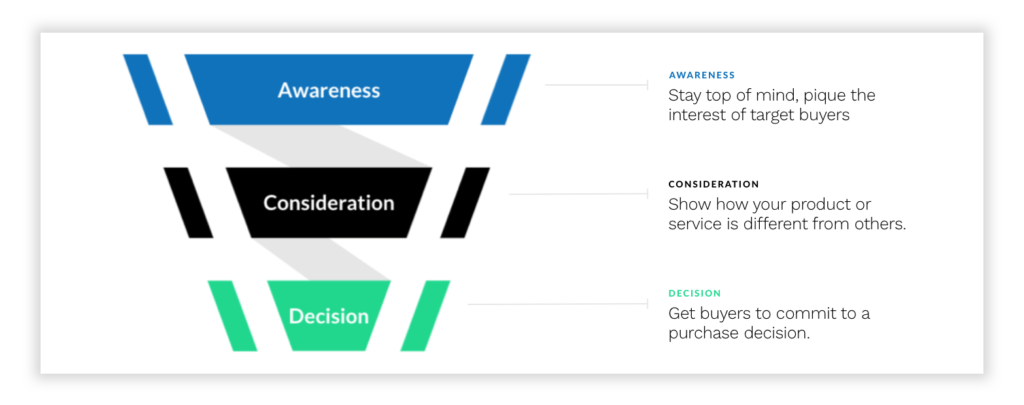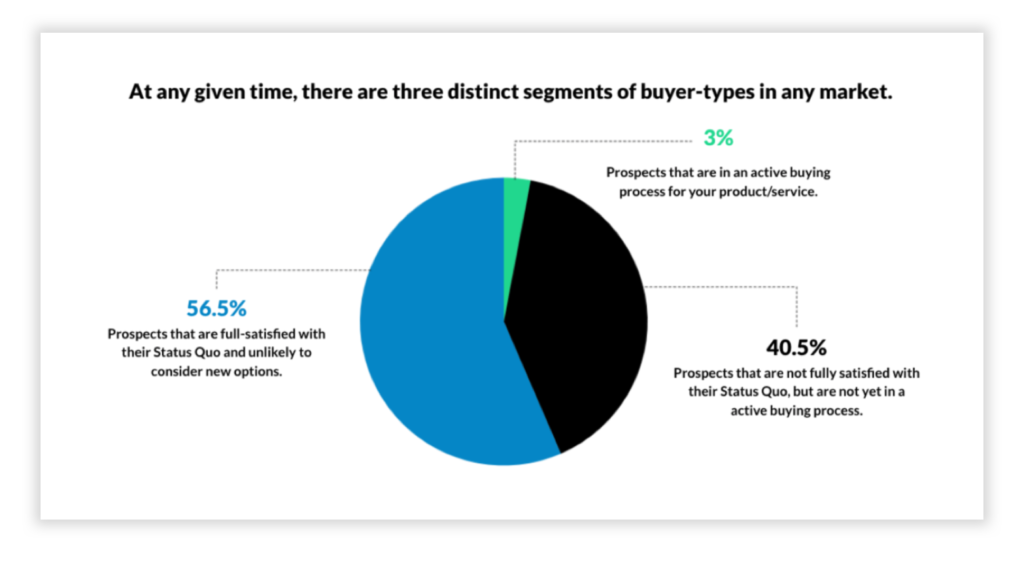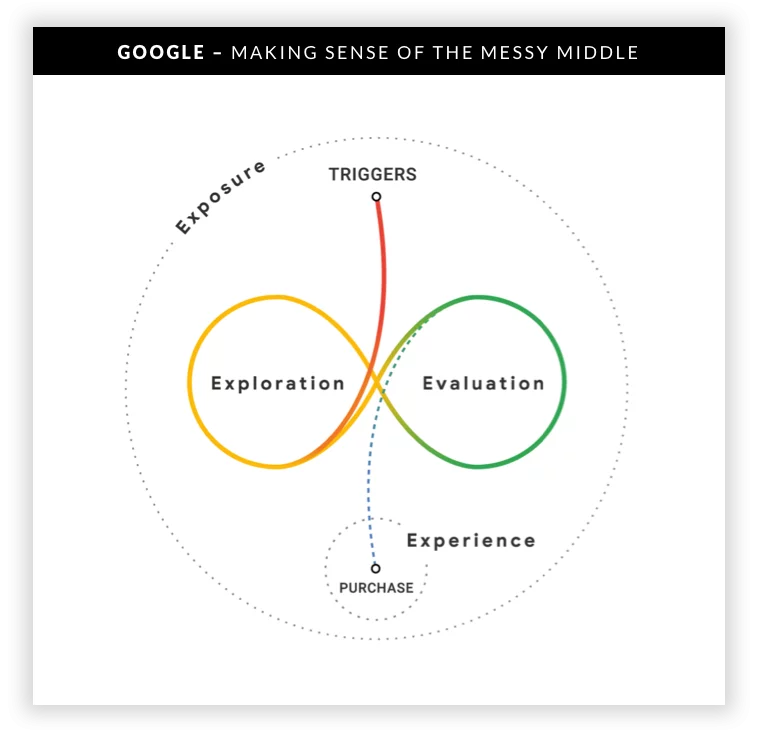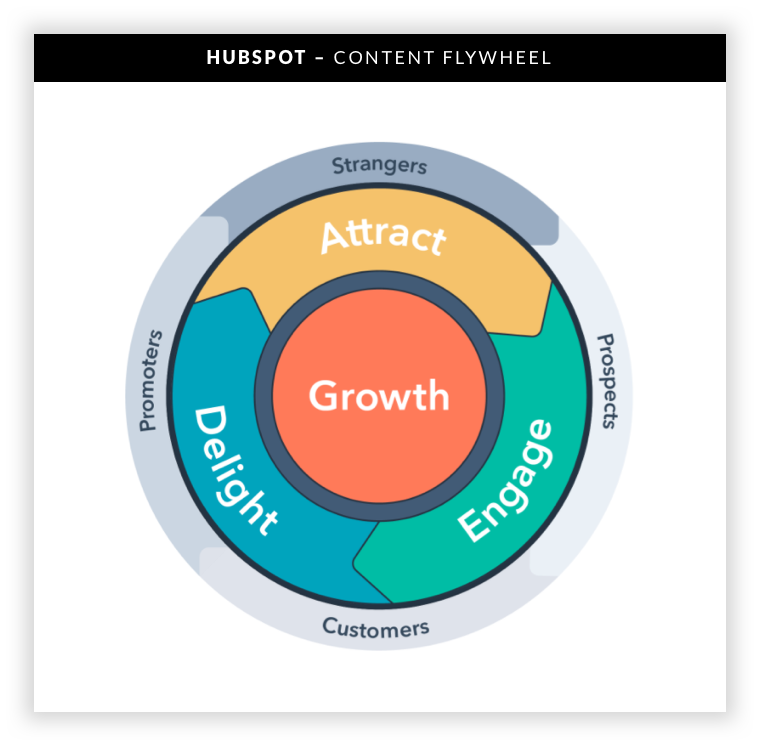Table of Contents
There are different ways to think about demand generation and the flow of buyers interacting with your brand. One easy concept to understand is the marketing funnel. But a “funnel” is simply a framework marketers created to visualize a system. It does not reflect actual human behavior. This article explains how to build a full funnel marketing strategy that meets buyers where they are in their journey.
The Marketing Funnel Explained
The marketing funnel is a tool to visualize an inbound lead generation model. It’s a simple way to communicate how marketing will achieve digital marketing objectives. It groups marketing activity neatly into categories, alleviating major pain points facing marketing heads that can lead to short tenures.
However, humans behave differently and a full funnel marketing strategy can easily be overcomplicated. I’ve spent years studying brands and marketing strategies, dissecting setups and systems. Every business—and the markets they sell to—are different.
This leads some marketers to believe their funnel is completely unique. This is true to some degree. But boiled down to the basics, there are three levels to a marketing funnel that relate to the kind of messages you want your buyers to see:

It’s important to note these categories reflect the goals of the content and messages at each level, not buyer behavior. Here is an overview of each:
Awareness
Awareness content typically has two goals. First, to stay top-of-mind for buyers satisfied with the status quo. Secondly, to pique the interest of buyers who question their current state. Eye-catching images and well-crafted copy hooks stop users from scrolling in social media feeds. Key messages attract the right buyers to take an action, like clicking through to a webpage or watching a video. Success at this level is typically measured by metrics like share of voice or impressions.
Consideration
Marketing messages and content in the middle of the funnel show buyers how your product or service is different from others. The goal is to give buyers the information they need to make a decision. Product comparison pages, downloadable reports, and lead nurture email content are common formats used at this stage. Performance is typically measured by the number of qualified leads generated from various sources like organic search or Facebook Ads.
Decision
Content at the bottom of the funnel should drive a decision. The goal is to get buyers to commit to a purchase, like signing a contract or providing credit card information. Limited-time offers or other discounts can be used to tip the scale for buyers. Marketing-sourced revenue is a common metric used to measure performance at the decision level.
How Does the Marketing Funnel Relate to the Customer Journey?
The funnel visual is biased. It views marketing as a series of activities, channels, and conversions. It’s useful to marketers, but it’s not reflective of actual buyer behavior. Let’s take a look at some different perspectives on why and how buyers buy.
At any given time, there are three distinct segments of buyers in any market
Robert F. Bales, a social psychology professor at Harvard University in the 1950s, created a method to measure the process of human interaction in small groups. This paved the way for modern market research. Findings from his research method suggest there are three groups of buyers in any market at any point in time, based on their purchase intent:
- Satisfied with the status quo (56.5%)
- Dissatisfied with the status quo (40.5%)
- Actively on a buying journey (3%)
Marketers should consider developing key messages for each segment. We’ll get into this more in the section below.

Customers hire products and services to do a “job”
Harvard Business School professor and author Clayton Christensen contends that customers hire products or services to do a job. This is known as the “theory of jobs to be done,” the first lesson in how companies succeed from his book, Competing Against Luck. Listen to the podcast episode below to hear Katelyn Bourgoin explain this concept with examples like milkshakes and CBD gummies:
How to Build a Full Funnel Marketing Strategy
Now that we know what a marketing funnel is and how it relates to the customer journey, let’s explore how to build it. First, investing in a full funnel marketing strategy requires both dollars and time. There are many moving parts to this kind of system, especially if you use channels like paid search or paid social for lead generation.
For it to be a success, you must take into account two things:
- Where your buyers are in their journey
- The right channels to reach buyers where they are
The image below groups buyer journey milestones with common marketing activity found at each stage of the funnel. This can be a useful reference when building a full funnel marketing strategy.

But where should marketers start investing resources? The answer depends on a number of factors, including your target market behavior, external environments, and your current inventory of marketing assets. Let’s explore scenarios for when it would make sense to start at each level.
The Bottom-Up Approach
In this approach, marketing investments focus first on decision-level content. These are your “money” pages where users can request a demo, estimate, or make a purchase.
Starting at the bottom of the funnel can be hard for some marketers who feel pressure to generate buzz and brand awareness. But focusing on the conversion points closest to revenue is the quickest way to prove return on investment in activities like SEO and paid media.
Once key stakeholders see proof of concept in a given channel, there will be more leeway to build out consideration-level content. Search-optimized product comparison pages, PDF downloadables, or email nurture sequences are typical formats for this kind of content. The goal of this content is to show how your product or service helps buyers improve their life. A key part of this stage of the funnel is to collect valuable first-party data, like email addresses.
Finally, awareness-level content can help drive web traffic to pages designed to capture email addresses. The goal of this content is to capture the attention of your target audience and entice them enough to take the next step.
The Middle-Out Approach
This approach can work well if you have strong differentiators and a sizable database of existing CRM contacts. The goal of this approach is to generate engagement from warm contacts, establish a repeatable way to monetize, then add more contacts to your funnel.
First, the focus is usually on building out a robust email marketing program. Audience segmentation, A/B tests, and automated nurture sequences are a few activities that can accelerate learnings that improve engagement. But these processes mean nothing if contacts don’t have any reason or interest in opening your emails. Content should add value to contacts, which can be done in two ways: 1) education or 2) entertainment.
The next step is to experiment with ways to monetize your engaged audience. Limited-time offers and exclusive discounts are two examples of how to convert engaged audiences.
Finally, investments can be made to build brand awareness and add new email addresses to your CRM. This fuels the marketing funnel with leads, and conversion points can be tested and iterated upon.
The Top-Down Approach
The top-down approach can work for businesses where demand is influenced by external factors. Content strategies for this approach are typically driven by news-worthy content.
For example, financial technology companies serving the cryptocurrency market need to monitor demand and market movements. Commanding attention in this space is difficult, but can be powerful if done right.
However, this can be an expensive and risky approach to building a full funnel marketing strategy. Marketers should consider the limitations of building an audience on rented land.
For example, paid media campaigns on platforms like LinkedIn can be useful to build audiences based on job titles or degrees. These audiences can easily be remarketed to on LinkedIn based on their user activity, but it will be much harder for marketers to cookie their own website users and re-target them the next time they login to their account.
Reduce Friction in your Marketing Funnel with Content Relevance
A full funnel marketing strategy won’t work unless you have the right message. Content relevance means the marketing messages you put in front of your target audience speak to a pain point your products or services address. It is the degree to which your content resonates with your audience.
There are three ways marketers can make sure their content is relevant at every stage of the marketing funnel:
Conduct Audience Research
Market research can be a powerful way to understand the pain points buyers face, the channels they use to learn, and how they make purchase decisions. Applying these insights makes content more likely to resonate.
Test Creative Elements
According to Nielsen, creative elements account for nearly 50% of an advertisement’s performance. Testing creative elements is a useful way to learn what imagery and copy resonates with target audiences.
Establish Feedback Loops
Establishing the right feedback loops within your digital marketing team structure helps iterate and improve campaigns, especially when buyers begin to show ad fatigue. This increases the speed of innovation and campaign iterations, which helps marketers learn more quickly what does and does not resonate with buyers.
Measuring Marketing Funnel Performance
Marketing technology has advanced to the point where many things can be automated. For instance, when a buyer downloads an eBook or registers for a webinar, they may be entered into an automated drip email nurture sequence. This kind of workflow is one example of how you can automate parts of your marketing funnel.
This level of automation can provide an overwhelming amount of data. Attempting to measure performance can easily leave marketers confused or frustrated. Here are some common KPIs to measure the success of a full-funnel marketing strategy.
Marketing-Sourced Revenue
How much did marketing activities like SEO, paid search or social contribute to revenue? Proving these activities drive revenue will help make the case for continued investment in a full funnel marketing strategy. This can be challenging without the right analytics setups and dashboards. Otherwise, your finance and executive teams won’t see the value.
Marketing Funnel Stage Conversion Rates
Do prospects who see awareness-level messages click through to consideration-level content? How many email addresses were you able to capture from those prospects? Are those leads taking meetings with sales reps? Knowing these conversion rates are important for measuring a full funnel marketing strategy.
Pipeline Velocity
Pipeline velocity is a measure of how fast buyers move through your marketing and sales process. It’s important to note this can vary depending on where buyers were in their journey when they first engaged with your brand. Users actively on a buying journey (3% market segment) will spend less time on your website and in your CRM than buyers who are satisfied with the status quo (56.5%). These folks on an active buying journey will have a faster pipeline velocity. However, that doesn’t mean you should forego awareness-level marketing and risk your pipeline drying up.
Return on Marketing Investment
“How does this impact our bottom line?” This can be a tough question to answer, especially when it comes to measuring activities like blog performance. However, this can be the single most important metric to understand when talking with senior leadership teams. This is why it’s critical to integrate marketing data with other business systems.
How Does the Marketing Funnel Compare to Other Marketing Models?
Google published a manifesto, titled Decoding Decisions: Making Sense of the Messy Middle, in which they describe the customer journey as having a “messy middle.” However, this strikes me as simply a top-down view of the traditional marketing funnel. The concepts are the same. Triggers set a prospect on a buying journey where they explore and evaluate solutions to their problem. These experiences accumulate into what some refer to as a buyer’s journey.

Below is how HubSpot visualizes their content flywheel. First, marketing attracts strangers who convert into prospects. Marketing and sales teams engage with prospects to turn them into customers. Finally, sales and service teams delight customers to the point where they become promoters of the brand, attracting new strangers into the fold.

Is a Full-Funnel Marketing Strategy Right for Your Business?
Companies who rely on leads to fuel sales have an opportunity to build and scale a full funnel marketing strategy. Doing this all in-house can be a major undertaking, and poses a risk since it takes time to scale inbound programs.
Explore how Silverback Strategies can help your business accelerate your inbound marketing funnel for lead generation. Request a consultation today.


